COLBINABBIN HOMESTEAD
87 OSMENT ROAD COLBINABBIN, CAMPASPE SHIRE
-
Add to tour
You must log in to do that.
-
Share
-
Shortlist place
You must log in to do that.
- Download report
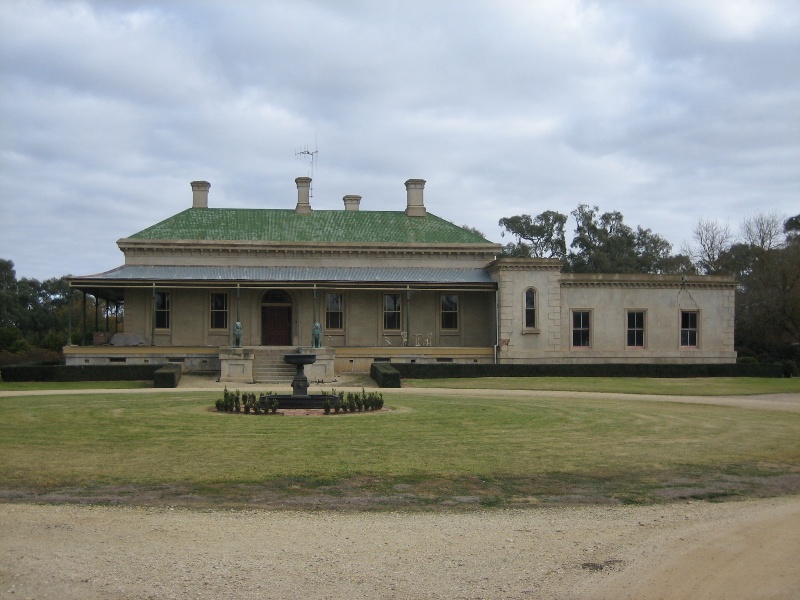

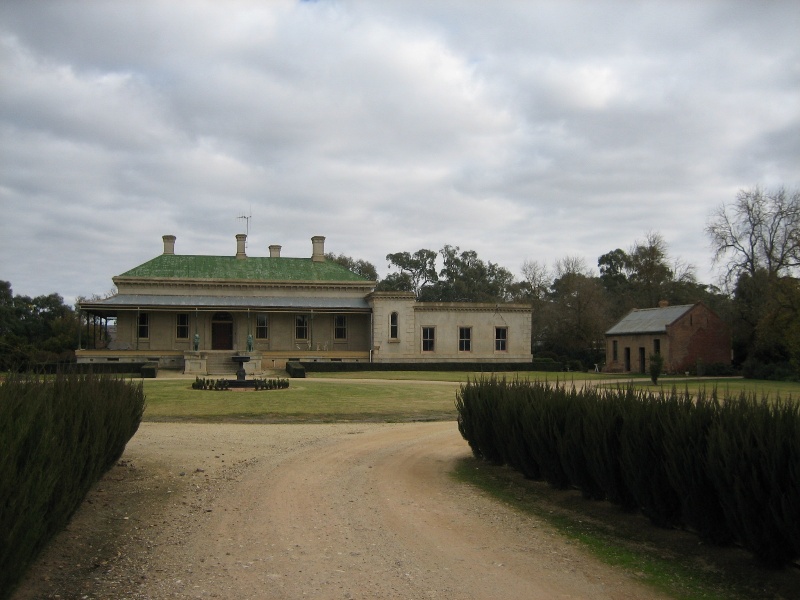


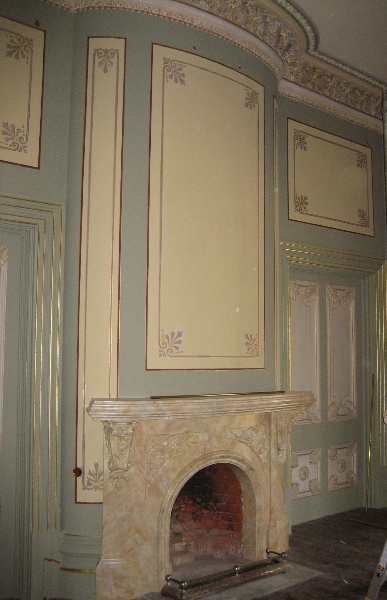
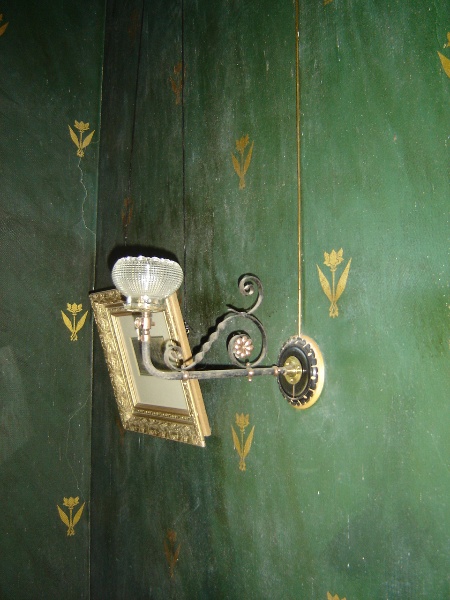
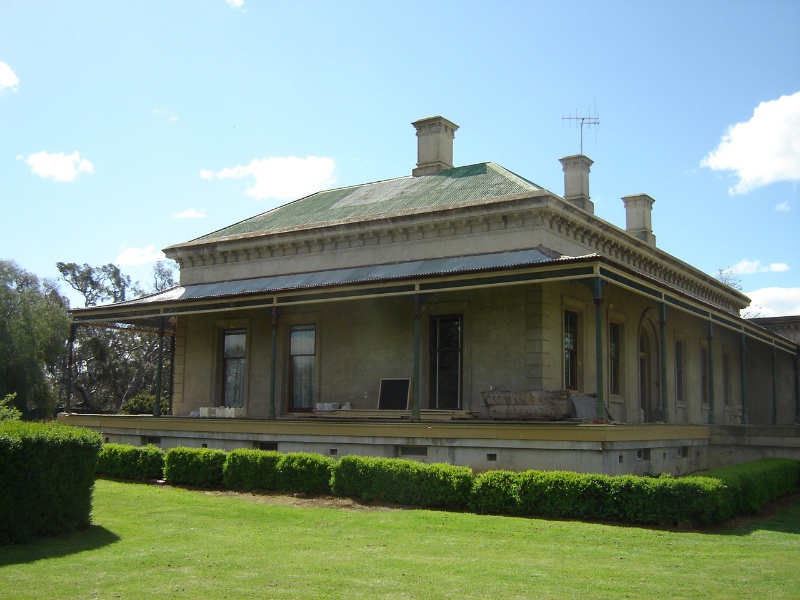










Statement of Significance
What is Significant?
Colbinabbin Homestead, an Italianate style single storey solid brick and stucco house with a cast iron a verandah with concave galvanised iron roof, was designed by Bendigo based architect, Robert Alexander Love, was and built for John Irving Winter in 1867. The Irving Winter Family owned large pastoral interests throughout Victoria , New South Wales and Queensland which were established with the proceeds of gold discovered on their land near Ballarat. The Colbinabbin run was established by William Curr in 1843 and was bought by John Winter for his four sons in 1857. John [Jock] Winter, the son of a blacksmith, arrived in Australia with his family from Scotland in 1841 and settled near Ballarat. The discovery of gold on their property transformed the life of the family and provided the basis for sizeable investment in large pastoral areas throughout northern Victoria. New South Wales and Queensland. In Victoria the wealth of these property owners was expressed in their homesteads. These included Dhurringile (H1554), built for James Irving Winter in 1877; Noorilim (H0297), built for William Irving Winter in 1879; and William's first homestead, Stanhope, also designed by Love in 1867 (now demolished).
The property was sold in 1887 to Melbourne builder David Mitchell (1829-1916) and was subdivided in 1907 in response to the Closer Settlement Act of 1904.
Colbinabbin Homestead is an Italianate style single storey solid brick and stucco building in two distinct parts.
The house is in two distinct but unified parts. The main body of the house consists of eight rooms arranged around a 'T' hallway layout that terminates at the service area at the house's northern end. This service area consists of two wings either side of a courtyard built over an underground brick lined tank. The western wing accommodating the kitchen was demolished at some point but was rebuilt in 2004.
The main body of the house of eight rooms has a cast iron a verandah on three sides with a concave galvanised iron roof with cast iron posts and trim. The external walls of the house rise to a low parapet with bracketed cornice in front of a concealed gutter.
The service area on the northern side of the house consists of two wings either side of a service courtyard with an underground brick lined tank. The wing accommodating the kitchen wing was demolished at some point but was rebuilt in 2004 with materials salvaged from the demolition of Stanhope.
The interior spaces of the principal rooms of the main body of the house are distinguished by a rare and n elaborate decorative scheme, displaying a range of high quality nineteenth century decorative techniques including examples of walnut wood graining to the doors, marbling to the fireplaces and hallway walls, painted and stencilled leather grained wallpaper, stencilled pattern work and fine paint detailing to pilaster capitals and plaster cornices. The front door has leaded and painted glass fanlight and side panels. The fanlight incorporates the family crest and date of construction. The two front rooms of the house are separated by a shared elliptical fireplace and painted panelled doors that slide up into the roof space above.
The homestead is nestled into the edge of Cornella Creek, and the garden is surrounded by River Red Gums on the west and south sides. The garden is enclosed on the north side by an old Osage Orange hedge, which curves around the eastern edge to meet up with River Red Gums to the south. O. Osage Orange, a native of North America, was imported in the 1850s for the purpose of a "living fence" and was first listed in 1857 by John Rule, a Richmond nurseryman and became widely available from nurseries in the 1860s-1899. The hedge at Colbinabbin is an unusually large planting and is the only known example where Osage Orange has been used to enclose a garden, and the curved eastern side is an attractive design feature.
The original garden has mostly been lost and the only surviving trees are 2 large English Elms at the south entrance which mark the line of the original drive. To the west of the homestead an Oleander, a Mulberry and a large spreading Pepper tree remains.
There are a number of associated outbuildings including a bakehouse, a shearing shed and a cattle dip. The bakehouse is of cavity brick wall construction. The two skins of the wall are tied by 37mm wide metal straps, placed at 900mm intervals, with ends looped around a metal band in each wall. There are two sets of these bands which run around the perimeter of the building, one below sill level and the other above head height. The date of construction for this building is believed to be soon after the construction of the house, if not contemporary with it. While various early forms of cavity brick walls were built throughout Victoria prior to the late 1860s, Love is credited with the introduction of the wire tied cavity wall to Victoria. The metal tied cavity wall became, and still is, the standard technique for full brick construction in Australia. It is believed to be amongst the earliest known examples of wire tied cavity brick construction in the state.
The woolshed is constructed of uniform diameter bush poles. The original shingle roof is still apparent under the later corrugated iron roof cladding. The building is believed to have originally accommodated 40 workers. The shearing boards were located along each side of one end of the building and were supplied with sheep from a central race fed from the larger internal sweating pens. The building is reported to have been shortened in response to the construction of the adjacent Waranga Western Channel built in the early part of the twentieth centu
There may be archaeological remains of' a substantial wool scouring works close to the woolshed, on the banks of Cornella Creek. These works were powered by a thirty five horse power steam engine that allowed the woolshed's daily clip to be scoured, dried and pressed within twenty four hours. In 1864 the works were scouring twenty bales a day. The scouring works were set up as joint enterprise by the Winter Brothers and also processed wool from their other run s. Thee works were part of a larger collection of buildings that were believed to also include amongst other activities, a boiling down works and a meat preserving works. Early photographs show a substantial chimney behind the scouring sheds. None of these structures are extant, but some remnant structure is still visible at ground level and it is believed that evidence of the other structures and the activities of the site are below ground level. The bricks from these structures are said to have been taken to Rushworth for use in the mines. Near to the location of the works is an extant brick lined cattle dip.
The property has a small cemetery to the south of the homestead on the banks of Cornella Creek where . Eeleven people were buried here between 1860 and 1870.
How is it Significant?
Colbinabbin Homestead is of architectural, historical, archaeological and aesthetic (landscape) significance to the State of Victoria.
Why is it Significant?
Colbinabbin Homestead is of historical significance as an important example of a substantial homestead built with the proceeds of gold discoveries and subsequent pastoral wealth.
Colbinabbin Homestead is of historical significance for its associations with its owner John Winter and the prominent Winter and Winter-Irving families who were among the largest pastoral landholders in Victoria.
Colbinabbin Homestead is of architectural significance as a fine example of the Victorian Italianate style. The house is also of note for its distinctive planning layout.
Colbinabbin Homestead is of architectural significance as a fine example of the Victorian Italianate style. The house is also of note for its planning: the main body of the house is based around a 'T' hallway form and the servants rooms and kitchens are located around a small attached courtyard.
Colbinabbin Homestead is of architectural significance for its rare and elaborate internal decoration. The decorative scheme is of particularly high quality and represents both the range and high level of skill of its nineteenth century decorators.
Colbinabbin Homestead is of architectural significance as an example of the work of Bendigo based architect, Robert Alexander Love (1814-76) and for the early use of cavity brick wall construction in the bakehouse.
Colbinabbin Homestead is of historical and archaeological significance as the site of a once large agricultural enterprise as represented by the woolshed and the cattle dip. It once also included a substantial industrial complex that incorporated a steam driven wool scouring works and is believed to have also included a boiling down works and a meat preserving works. The site has archaeological potential to yield important in situ remains, including artefact deposits, relating to the 19th Century agricultural industrial complex.
The garden is of historical and landscape significance for its use of Osage Orange (Maclura pomifera) as a hedge plant.
-
-
COLBINABBIN HOMESTEAD - History
History
Colbinabbin Homestead, designed by Bendigo based architect, Robert Alexander Love, was built for John Irving Winter in 1867. The Colbinabbin run was established by William Curr in 1843 and was bought by John Winter for his four sons in 1857. John [Jock] Winter, the son of a blacksmith, arrived in Australia with his family from Scotland in 1841 and settled near Ballarat. The discovery of gold on their Ballarat property transformed the life of the family and provided the basis for sizeable investment in large pastoral areas throughout northern Victoria. New South Wales and Queensland.
In Victoria the wealth of the family was expressed in their homesteads. These include Dhurringile (H1554), built for James Irving Winter in 1877; Noorilim (H0297), built for William Irving Winter in 1879; and William's first homestead, Stanhope, also designed by Love in 1867.John Irving Winter never married but had two illegitimate children, who on Winters death in 1877 were sent elsewhere by Winter's executors. The property was sold ten years later, in1887, to Melbourne builder David Mitchell (1829-1916) and was eventually subdivided in response to the Closer Settlement Act of 1904.
Notes
The Colbinabbin Run was first selected by Edward Curr in 1843 and was bought from by John Winter for his our sons in 1857. (M. Butcher, Robert Alexander Love - Goldfields Architect, p.66)Winter family had extensive landholding throughout Victoria , NSW and QLD. (ibid)
The four Winters brothers built four substantial house in northern Victoria:
Noorilim, owned by William Irving Winter, designed by James Gall, 1879
Dhurringile, James Irving Winter, designed by Lloyd Taylor, 1875
Stanhope, William Irving Winter, designed by R A Love, 1867
Colbinabbin, John Irving Winter, designed by R A Love, 1867Miles Lewis credits Love with introducing the true cavity wall to Victoria. (Australian Building, A Cultural Investigation, p.6.03.13)
Outbuilding at Colbinabbin of considerable technical interest as the hollow walls are bonded with metal strips at two heights in the walls. It is unknown if the design bellows to Love, but Butcher believes it is safe to assume that it was. It is not known when it was but if it was built at the same time as the homestead, 1867, the first use by Love of metal bonding I cavity wall, a practise he used at Stawell in 1869 (M. Butcher, Robert Alexander Love - Goldfields Architect, p.32)
The works were part of a larger collection of buildings that were believed to also include amongst other activities, a boiling down works and a meat preserving works (Eril Bassed, Special Study Research Essay)
Close to the woolshed, on the banks of Cornella Creek, the property also once accommodated a substantial wool scouring works. These works were powered by a thirty five house power steam engine that allowed the woolshed's daily clip to be scoured, dried and pressed within twenty four hours. In 1864 the works were scouring twenty bails a day. The scouring works was set up as consortium between the Winter Brothers and also processed wool from their other runs. (Riverina Herald 8 December 1864)
The bricks from these structures is said to have been taken to Rushworth for use in the mines. (Bruce & Alison Bassed, owners)
COLBINABBIN HOMESTEAD - Plaque Citation
Colbinabbin Homestead is an Italianate style residence, designed by architect Robert Alexander Love for John Irving Winter in 1867. The Winter family were among the largest pastoral landholders in Victoria.
COLBINABBIN HOMESTEAD - Permit Exemptions
General Exemptions:General exemptions apply to all places and objects included in the Victorian Heritage Register (VHR). General exemptions have been designed to allow everyday activities, maintenance and changes to your property, which don’t harm its cultural heritage significance, to proceed without the need to obtain approvals under the Heritage Act 2017.Places of worship: In some circumstances, you can alter a place of worship to accommodate religious practices without a permit, but you must notify the Executive Director of Heritage Victoria before you start the works or activities at least 20 business days before the works or activities are to commence.Subdivision/consolidation: Permit exemptions exist for some subdivisions and consolidations. If the subdivision or consolidation is in accordance with a planning permit granted under Part 4 of the Planning and Environment Act 1987 and the application for the planning permit was referred to the Executive Director of Heritage Victoria as a determining referral authority, a permit is not required.Specific exemptions may also apply to your registered place or object. If applicable, these are listed below. Specific exemptions are tailored to the conservation and management needs of an individual registered place or object and set out works and activities that are exempt from the requirements of a permit. Specific exemptions prevail if they conflict with general exemptions. Find out more about heritage permit exemptions here.Specific Exemptions:General Conditions: 1.
All exempted alterations are to be planned and carried out in a manner which prevents damage to the fabric of the registered place or object.General Conditions: 2.
Should it become apparent during further inspection or the carrying out of works that original or previously hidden or inaccessible details of the place or object are revealed which relate to the significance of the place or object, then the exemption covering such works shall cease and Heritage Victoria shall be notified as soon as possible. Note: All archaeological places have the potential to contain significant sub-surface artefacts and other remains. In most cases it will be necessary to obtain approval from the Executive Director, Heritage Victoria before the undertaking any works that have a significant sub-surface component.General Conditions: 3.
General Conditions: 4.
If there is a conservation policy and plan endorsed by the Executive Director, all works shall be in accordance with it. Note: The existence of a Conservation Management Plan or a Heritage Action Plan endorsed by the Executive Director, Heritage Victoria provides guidance for the management of the heritage values associated with the site. It may not be necessary to obtain a heritage permit for certain works specified in the management plan.
Nothing in this determination prevents the Executive Director from amending or rescinding all or any of the permit exemptions. General Conditions: 5.
Nothing in this determination exempts owners or their agents from the responsibility to seek relevant planning or building permits from the responsible authorities where applicable.Minor Works :
Any Minor Works that in the opinion of the Executive Director will not adversely affect the heritage significance of the place may be exempt from the permit requirements of the Heritage Act. A person proposing to undertake minor works may submit a proposal to the Executive Director. If the Executive Director is satisfied that the proposed works will not adversely affect the heritage values of the site, the applicant may be exempted from the requirement to obtain a heritage permit. If an applicant is uncertain whether a heritage permit is required, it is recommended that the permits co-ordinator be contacted.Regular Site Maintenance :
The following site maintenance works are permit exempt under section 66 of the Heritage Act 1995,
a) regular site maintenance provided the works do not involve the removal or destruction of any significant above-ground features or sub-surface archaeological artefacts or deposits;
b) the maintenance of an item to retain its conditions or operation without the removal of or damage to the existing fabric or the introduction of new materials;
c) cleaning including the removal of surface deposits, organic growths, or graffiti by the use of low pressure water and natural detergents and mild brushing and scrubbing;
d) repairs, conservation and maintenance to plaques, memorials, roads and paths, fences and gates and drainage and irrigation.
e) the replacement of existing services such as cabling, plumbing, wiring and fire services that uses existing routes, conduits or voids, and does not involve damage to or the removal of significant fabric.
Note: Surface patina which has developed on the fabric may be an important part of the item?s significance and if so needs to be preserved during maintenance and cleaning.
Note: Any new materials used for repair must not exacerbate the decay of existing fabric due to chemical incompatibility, obscure existing fabric or limit access to existing fabric for future maintenance. Repair must maximise protection and retention of fabric and include the conservation of existing details or elements.Landscape:
Landscape Maintenance : The process of gardening and maintenance, mowing, hedge clipping, bedding displays, removal of dead plants, disease and weed control, emergency and safety works to care for existing plants.COLBINABBIN HOMESTEAD - Permit Exemption Policy
The purpose of a Permit Exemption is to allow works that will not impact on the significance of the heritage place to occur without the need for a permit. Works other than those mentioned in the permit exemptions may be possible but will require permit approval or the written approval of the Executive Director.
The purpose of the Permit Policy is as a guide only in assisting when considering, or making decisions regarding, works to the place.
It is recommended that any proposed works be discussed with an officer of Heritage Victoria before they are undertaken or a permit is applied for.
The decorative elements and applications in the house are of prime significance and represent a rare and comprehensive collection of nineteenth century decorative techniques. While the conservation and restoration of this decoration is encouraged, any proposal that would remove or cover any original decorative element should be avoided. Any proposal that would introduce any new colour schemes, alter or affect the existing colour schemes should be avoided. Any proposal to introduce any new decorative schemes or elements should similarly be avoided. The original rooms and new kitchen surrounding the northern courtyard can be repainted and decorated without adversely affecting the heritage significance of the place.
The northern section of the eastern wing of buildings surrounding the northern courtyard is in partial state of collapse. It is expected that remedial work will be required to this part of the house and may require the removal and rebuilding of the affected sections of the structure. While the conservation and restoration of part of the house is encouraged, this work will still require a permit.
While it is understood that the woolshed has been significantly altered throughout its history and continues to be used, the original structure appears in good condition and the place still clearly illustrates the processes and activities that were undertaken, and continue to be undertaken, there. Ongoing maintenance to the structure should not require a permit but major maintenance works may require permit approval or the written approval of the Executive Director. Any proposal that would alter the remaining layout of the pens, races, shearing boards and other traditional zones and functions of the shed, and their understanding, should be avoided.
It is expected that land included in the extent of registration will continued to be used for agricultural purposes, including cultivation and grazing, however disturbance of any area of archaeological significance should be avoided. These areas include the location of the cemetery and the area that included the scouring works and other industrial processes on the banks of Cornella Creek near the woolshed. It is also recommended that the remains of the old bridge near these works are undisturbed.
The bakehouse is of significance for its early cavity wall construction. Any proposal to remove any section of wall or introduce any new opening should be avoided. The internal fabric of the bakehouse including flooring and ceiling boards is intrinsic to the understanding of the place and any proposal to remove or alter these should be avoided.
Although not a requirement, the preparation of a Conservation Management Plan for Colbinabbin Homestead would greatly assist in the future management of the place.
-
-
-
-
-
COLBINABBIN HOMESTEAD
 Victorian Heritage Register H1730
Victorian Heritage Register H1730
-
'The Pines' Scout Camp
 Hobsons Bay City
Hobsons Bay City -
106 Nicholson Street
 Yarra City
Yarra City -
12 Gore Street
 Yarra City
Yarra City
-
-










